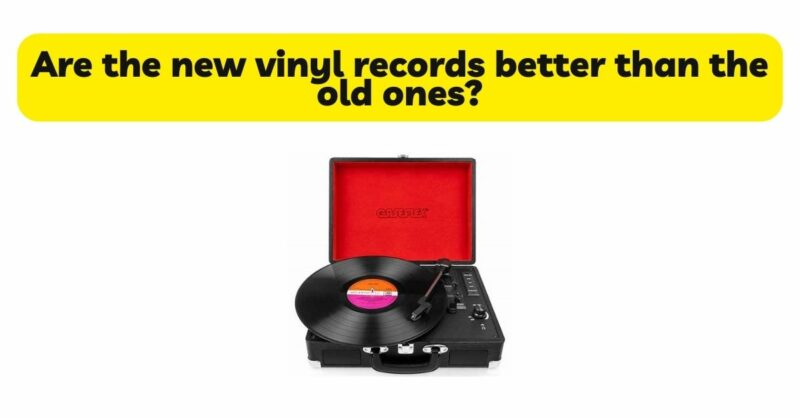In recent years, vinyl records have experienced an impressive resurgence in popularity. Audiophiles and music enthusiasts have embraced this analog format, drawn to its nostalgic charm and warmer sound. With the renewed interest in vinyl records, manufacturers have re-entered the market, producing new vinyl records using modern technologies and manufacturing processes. This has sparked a debate among collectors and audiophiles: are these new vinyl records better than the old ones? This article aims to explore the key differences between new and old vinyl records, examining various aspects that impact the overall listening experience.
- Manufacturing Techniques and Quality Control
Old vinyl records were primarily manufactured using analog methods, which often resulted in inconsistent quality and variations in sound. The manufacturing process involved cutting grooves into lacquer discs, which were then electroplated to create the stampers used for mass production. This manual process introduced potential errors and imperfections in the final product.On the other hand, modern vinyl record production has seen significant advancements in manufacturing techniques. With the advent of computer-controlled machinery and laser-cutting technology, new vinyl records are produced with greater precision and consistency. Additionally, the use of high-quality materials has improved the overall durability of modern vinyl records, reducing the chances of warping and surface defects.
- Sound Quality and Mastering
One of the key considerations when comparing new and old vinyl records is the sound quality. Advocates of vintage vinyl records often argue that they possess a certain warmth and depth that modern pressings cannot replicate. This is partially attributed to the mastering process, where older records were often mastered with a more dynamic range and less aggressive compression compared to some modern releases.However, it is essential to note that not all old vinyl records boast superior sound quality. Many vintage records have experienced wear and tear over the years, resulting in surface noise, pops, and clicks. In contrast, newly pressed vinyl records often benefit from improved mastering techniques and remastering from original master tapes, resulting in cleaner and more faithful reproductions.
- Vinyl Material and Pressing Quality
Vinyl records are made from polyvinyl chloride (PVC), and the quality of the vinyl material plays a crucial role in the overall sound and longevity of the record. Old vinyl records were often produced using recycled or lower-grade PVC, which contributed to the degradation of sound quality over time.Modern vinyl records, however, have access to higher-quality PVC materials, leading to a more stable and durable product. The use of virgin vinyl reduces the risk of impurities in the records, ensuring a cleaner sound and a longer lifespan. Additionally, new pressing plants are equipped with sophisticated machinery, allowing for greater precision in the vinyl pressing process and reducing the likelihood of defects such as off-center pressings or non-fill issues.
- Availability and Rarity
Old vinyl records can hold significant value for collectors, especially when it comes to rare and sought-after releases. The scarcity of certain vintage records can drive prices to extraordinary heights, creating a strong allure for collectors.
On the other hand, the renewed interest in vinyl has prompted record labels to reissue classic albums and artists to release new music on vinyl. While some purists argue that these reissues lack the authenticity of original pressings, they do provide more accessible options for casual listeners and enthusiasts who may not afford or find rare vintage records.
- Cover Art and Packaging
The physicality of vinyl records extends beyond the music itself, with cover art and packaging playing a significant role in the overall appeal. Old vinyl records often boasted intricate and creative cover designs that have become iconic in music history.In modern vinyl production, there has been a resurgence of attention to detail in cover art and packaging, often replicating the original designs with added enhancements for collectors. Additionally, advancements in printing technology have allowed for higher-resolution images and improved quality overall.
Conclusion
The debate over whether new vinyl records are better than old ones is subjective and largely dependent on personal preferences and priorities. While vintage records can offer a unique listening experience and hold sentimental value, modern vinyl records have the advantage of improved manufacturing techniques, sound quality, and availability.Ultimately, both old and new vinyl records contribute to the rich tapestry of the vinyl culture. Whether you prefer the vintage allure or embrace the convenience and quality of contemporary pressings, the joy of collecting and listening to vinyl records is an experience that transcends the boundaries of time.


